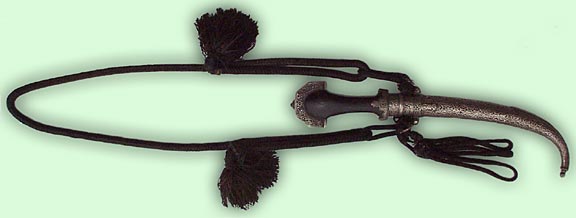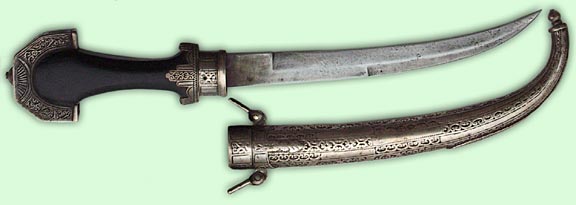Koummya: Moroccan Daggers
The koummya is the characteristic traditional dagger of the Berber and Arabic peoples of Morocco. Stone classifies these as being one localized variant of the Arabic jambiya, and the contoured handles, curved double-edged blades and exaggeratedly upturned scabbard tips are all features consistent with such an interpretation. In the context of the traditional regional manner of dress, the koummya is worn visibly at the left side, generally about at the level of the waist and is suspended vertically, with the scabbard tip forward, by a long woolen baldric, attached at either end to one of the two scabbard rings, and worn crossing in front and back of the torso and over the right shoulder. A much greater diversity in forms and decoration exists than is represented by the examples presented in this essay and presumably such features could be used to place particular examples geographically and temporally.
 |
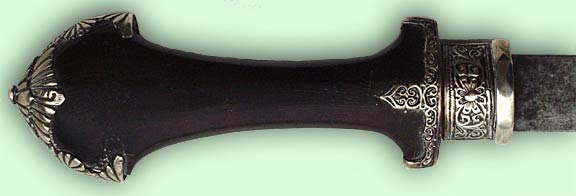 |
|
|
Koummya blades are curved and double edged with the portion nearer the hilt remaining relatively straight while the curvature becomes pronounced in the half towards the tip. The length of the blade which is beveled and sharpened is longer along the concave side than along the opposite convex side. Blade thickness tapers from the base of the blade, where it is thickest, to the tip. While the edge bevels may give the blade a flattened diamond or lenticular cross-section towards the tip, the cross-section is rectangular at the forte. These blades are characteristically relatively thin and utilitarian and the presence of fullers or ridges is not typical.
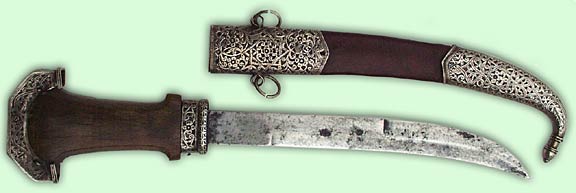 |
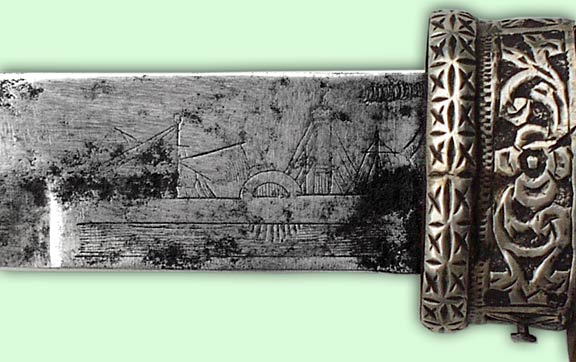 |
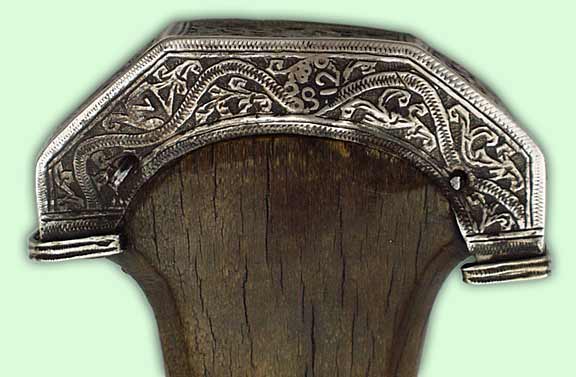 |
|
|
The hilts are characteristically made of a single piece of wood, although other materials including rhinoceros horn may be encountered, as well as examples with hilts entirely encased in metal. The central area of the usually smooth grip is narrowed relative to the width just before the ferrule (the band adjacent to the root of the blade) and the opposite pommel end flares out in a manner sometimes described as being reminiscent of an arch or a peacock's tail. The pommel is usually covered by an engraved metal cap which is secured in place by resin, tacks and or the peened end of the tang. The ferrule often expands to slide over the mouth of the scabbard by a few millimeters, presumably as a rain guard.
The scabbards are lined by two slabs of wood, one against each blade face, and usually held together and encased in metal decorated in the same manner as the hilt. A few centimeters from the mouth of the scabbard, in the plane of the blade, are two lugs, one on either side, to which are attached rings for suspension. The curvature of the scabbard follows that of the blade for the length of the blade and then becomes more exaggerated, making almost a ninety degree turn within a few centimeters before ending in a finial. The scabbards will usually have a metal reinforcement plate covering the distal one-third to two-fifths of the midline along the convex cutting edge.
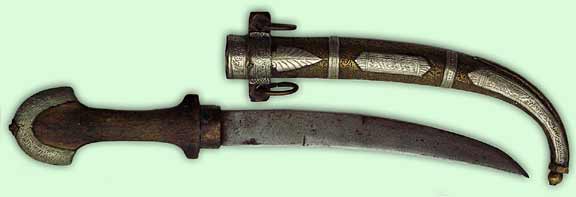 |
 |
|
|
Tourist grade koummyas of varying degrees of quality exist in abundance and may be found at almost all arms fairs and flea markets. It is difficult to walk even a block in the Marakkech market without being aggressively offered the opportunity to purchase one or several at "bargain" prices. At the close of the 20th century, the style of the typical tourist offerings had become somewhat more flashy than the example shown, often with mounts of white metal sometimes set with colorful stones and usually being of somewhat diminished size, particularly thinner. Little effort appears to have been expended on the blades of such knives, while a surprising amount of hand work has often gone into the mountings, especially considering that these knives can usually be had for about five to ten dollars even by a weak bargainer.
Spring, Christopher, African Arms and Armour, (London: British Museum Press, 1993). A few examples are illustrated, as is the manner of wear, along with a brief description on pages 24 -26.
Stone, George Cameron, A Glossary of the Construction, Decoration and Use of Arms and Armor in All Countries and in All Times (New York: Jack Brussel, 1961). Brief mention is made under the heading of jambiya, pages 310 - 314.
